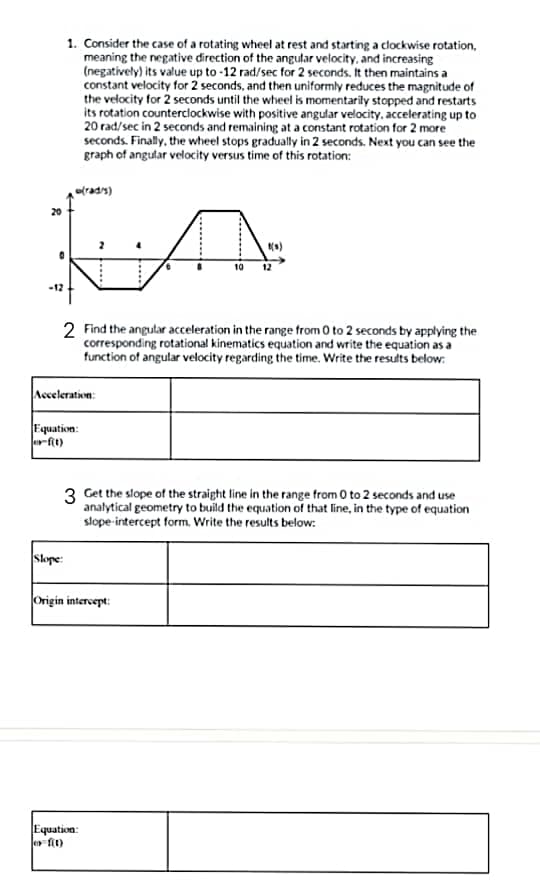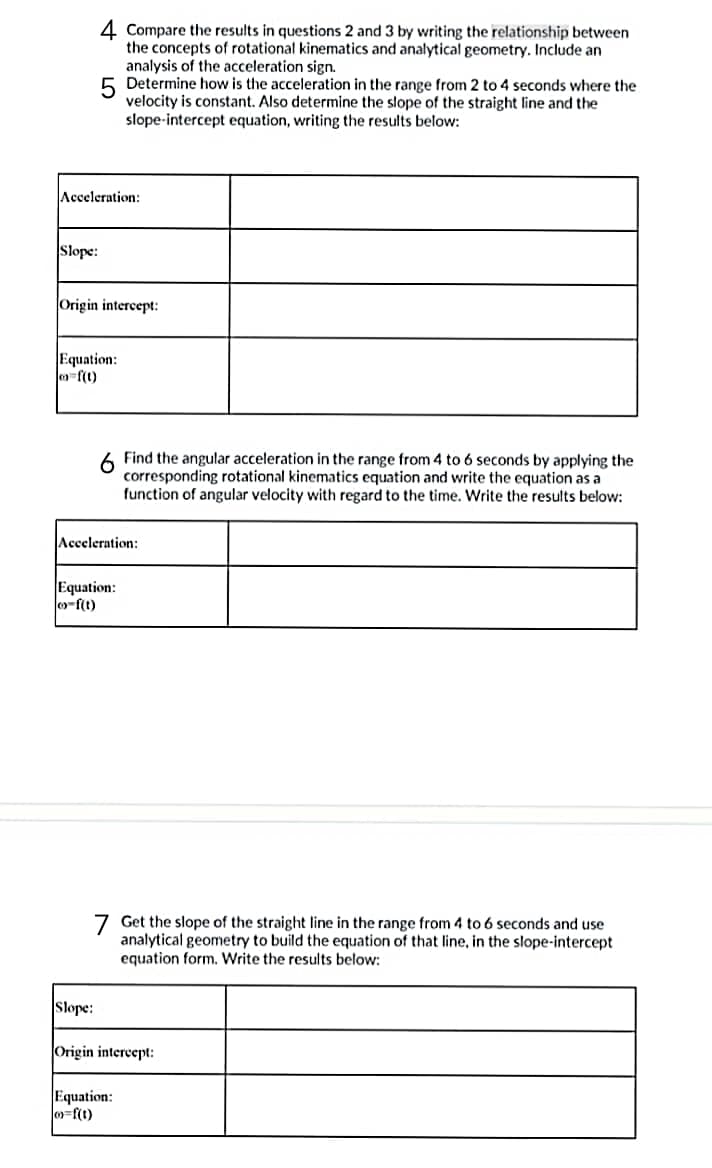. Consider the case of a rotating wheel at rest and starting a clockwise rotation, meaning the negative direction of the angular velocity, and increasing (negatively) its value up to -12 rad/sec for 2 seconds. It then maintains a constant velocity for 2 seconds, and then uniformly reduces the magnitude of the velocity for 2 seconds until the wheel is momentarily stopped and restarts its rotation counterclockwise with positive angular velocity, accelerating up to 20 rad/sec in 2 seconds and remaining at a constant rotation for 2 more seconds. Finally,. the wheel stops gradually in 2 seconds. Next you can see the graph of angutar velocity versus time of this rotation:
. Consider the case of a rotating wheel at rest and starting a clockwise rotation, meaning the negative direction of the angular velocity, and increasing (negatively) its value up to -12 rad/sec for 2 seconds. It then maintains a constant velocity for 2 seconds, and then uniformly reduces the magnitude of the velocity for 2 seconds until the wheel is momentarily stopped and restarts its rotation counterclockwise with positive angular velocity, accelerating up to 20 rad/sec in 2 seconds and remaining at a constant rotation for 2 more seconds. Finally,. the wheel stops gradually in 2 seconds. Next you can see the graph of angutar velocity versus time of this rotation:
Physics for Scientists and Engineers, Technology Update (No access codes included)
9th Edition
ISBN:9781305116399
Author:Raymond A. Serway, John W. Jewett
Publisher:Raymond A. Serway, John W. Jewett
Chapter10: Rotation Of A Rigid Object About A Fixed Axis
Section: Chapter Questions
Problem 10.2OQ: Consider an object on a rotating disk a distance r from its center, held in place on the disk by...
Related questions
Concept explainers
Angular speed, acceleration and displacement
Angular acceleration is defined as the rate of change in angular velocity with respect to time. It has both magnitude and direction. So, it is a vector quantity.
Angular Position
Before diving into angular position, one should understand the basics of position and its importance along with usage in day-to-day life. When one talks of position, it’s always relative with respect to some other object. For example, position of earth with respect to sun, position of school with respect to house, etc. Angular position is the rotational analogue of linear position.
Question
I need answers for 4 5 6 and 7

Transcribed Image Text:1. Consider the case of a rotating wheel at rest and starting a clockwise rotation,
meaning the negative direction of the angular velocity, and increasing
(negatively) its value up to -12 rad/sec for 2 seconds, It then maintains a
constant velocity for 2 seconds, and then uniformly reduces the magnitude of
the velocity for 2 seconds until the wheel is momentarily stopped and restarts
its rotation counterclockwise with positive angufar velocity, accelerating up to
20 rad/sec in 2 seconds and remaining at a constant rotation for 2 more
seconds. Finally, the wheel stops gradually in 2 seconds. Next you can see the
graph of angutar velocity versus time of this rotation:
rads)
10
12
2 Find the angular acceleration in the range from 0 to 2 seconds by applying the
corresponding rotational kinematics equation and write the equation as a
function of angular velocity regarding the time. Write the results below:
Acceleration:
Equation:
rfit)
3 Get the slope of the straight line in the range from 0 to 2 seconds and use
analytical geometry to build the equation of that line, in the type of equation
slope-intercept form. Write the results below:
Slkope:
Origin intercept:
Equation:
e ft)

Transcribed Image Text:4 Compare the results in questions 2 and 3 by writing the relationship between
the concepts of rotational kinematics and analytical geometry. Include an
analysis of the acceleration sign.
5 Determine how is the acceleration in the range from 2 to 4 seconds where the
velocity is constant. Also determine the slope of the straight line and the
slope-intercept equation, writing the results below:
Acceleration:
Slope:
Origin intercept:
Equation:
f(t)
Find the angular acceleration in the range from 4 to 6 seconds by applying the
corresponding rotational kinematics equation and write the equation as a
function of angular velocity with regard to the time. Write the results below:
Acceleration:
Equation:
o-f(t)
7 Get the slope of the straight line in the range from 4 to 6 seconds and use
analytical geometry to build the equation of that line, in the slope-intercept
equation form. Write the results below:
Slope:
Origin intercept:
Equation:
0=f(t)
Expert Solution
This question has been solved!
Explore an expertly crafted, step-by-step solution for a thorough understanding of key concepts.
Step by step
Solved in 2 steps with 2 images

Knowledge Booster
Learn more about
Need a deep-dive on the concept behind this application? Look no further. Learn more about this topic, physics and related others by exploring similar questions and additional content below.Recommended textbooks for you

Physics for Scientists and Engineers, Technology …
Physics
ISBN:
9781305116399
Author:
Raymond A. Serway, John W. Jewett
Publisher:
Cengage Learning

Principles of Physics: A Calculus-Based Text
Physics
ISBN:
9781133104261
Author:
Raymond A. Serway, John W. Jewett
Publisher:
Cengage Learning

Physics for Scientists and Engineers with Modern …
Physics
ISBN:
9781337553292
Author:
Raymond A. Serway, John W. Jewett
Publisher:
Cengage Learning

Physics for Scientists and Engineers, Technology …
Physics
ISBN:
9781305116399
Author:
Raymond A. Serway, John W. Jewett
Publisher:
Cengage Learning

Principles of Physics: A Calculus-Based Text
Physics
ISBN:
9781133104261
Author:
Raymond A. Serway, John W. Jewett
Publisher:
Cengage Learning

Physics for Scientists and Engineers with Modern …
Physics
ISBN:
9781337553292
Author:
Raymond A. Serway, John W. Jewett
Publisher:
Cengage Learning

Physics for Scientists and Engineers
Physics
ISBN:
9781337553278
Author:
Raymond A. Serway, John W. Jewett
Publisher:
Cengage Learning

Physics for Scientists and Engineers: Foundations…
Physics
ISBN:
9781133939146
Author:
Katz, Debora M.
Publisher:
Cengage Learning

College Physics
Physics
ISBN:
9781305952300
Author:
Raymond A. Serway, Chris Vuille
Publisher:
Cengage Learning